#Gemini Observatory
Explore tagged Tumblr posts
Text
This ethereal image, captured from Chile by the international Gemini Observatory, a Program of NSF's NOIRLab, looks as delicate as a butterfly’s wing. It is, however, a structure known as the Chamaeleon Infrared Nebula, which is located near the center of the even larger Chamaeleon I dark cloud, one of the nearest star-forming regions in our Milky Way.
#Somewhere Deep In The Night#Chameleon Infrared Nebula#NSF NOIR Lab#Gemini Observatory#astronomy#Keep Looking Up
0 notes
Text
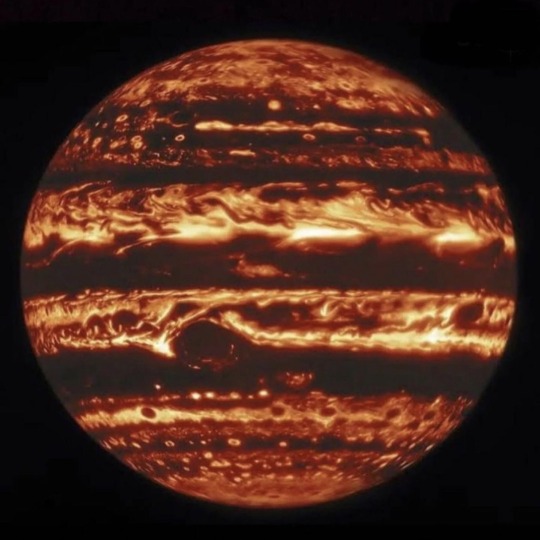
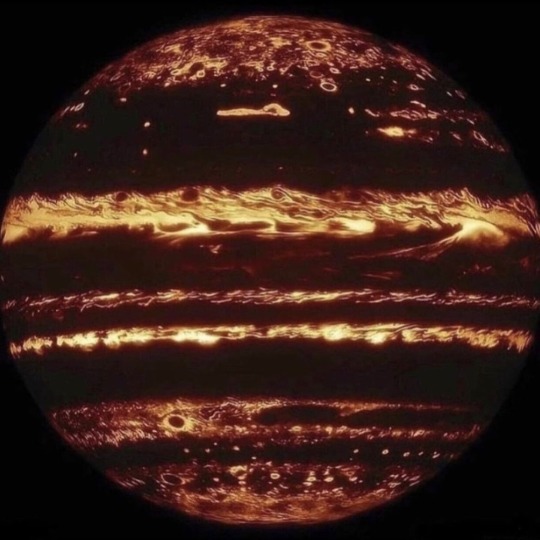
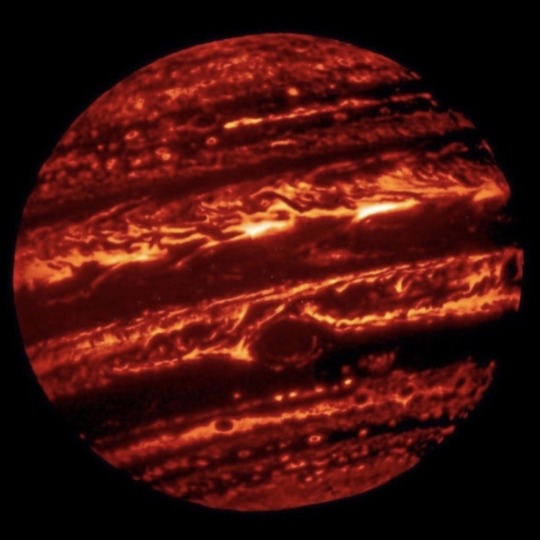
Clearest picture of Jupiter, from Earth. Isn't she beautiful? Actually hundreds of photos taken by the Gemini North Telescope in Hawaii, compiled to produce the infrared snap in order to see beyond Jupiter’s hazy atmosphere.
#aesthetic#jupiter#space#astronomy#astrophotography#w-o-w#photography#tale#gemini#observatory#nasa#planet
14K notes
·
View notes
Text

A Geminid meteor streaks across the sky as the Soyuz TMA-19M spacecraft is rolled out by train to the launch pad at the Baikonur Cosmodrome on Sunday, Dec. 13, 2015, in Kazakhstan. Credit: NASA/Joel Kowsky
Make a Wish! How to See the Geminid Meteor Shower
Every December, we have a chance to see one of our favorite meteor showers – the Geminids. To help you prepare, we’ve answered some of your most commonly asked questions. Happy viewing, stargazers!
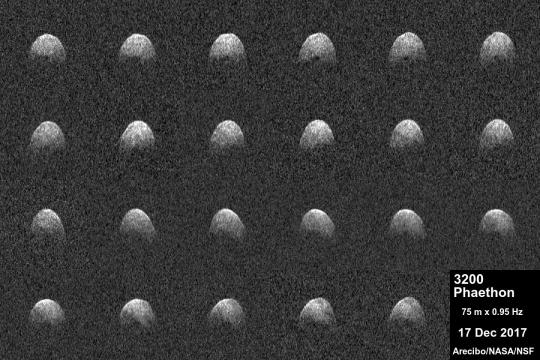
These radar images of near-Earth object 3200 Phaethon were generated by astronomers at the National Science Foundation's Arecibo Observatory on Dec. 17, 2017. Observations of Phaethon were conducted at Arecibo from Dec. 15 through 19, 2017. At time of closest approach on Dec. 16 at 3 p.m. PST (6 p.m. EST, 2300 UTC), the asteroid was about 6.4 million miles (10.3 million kilometers) away, or about 27 times the distance from Earth to the Moon. Credit: Arecibo Observatory/NASA/NSF
What are the Geminids?
The Geminids are caused by debris from a celestial object known as 3200 Phaethon striking Earth’s atmosphere. Phaethon’s origin is the subject of some debate. Some astronomers consider it to be an extinct comet, based on observations showing some small amount of material leaving its surface. Others argue that it has to be an asteroid because of its orbit and its similarity to the main-belt asteroid Pallas.

All meteors appear to come from the same place in the sky, which is called the radiant. The Geminids appear to radiate from a point in the constellation Gemini, hence the name “Geminids.” The graphic shows the radiants of 388 meteors with speeds of 35 km/s observed by the NASA Fireball Network in December 2020. All the radiants are in Gemini, which means they belong to the Geminid shower. Credit: NASA
Why are they called the Geminids?
All meteors associated with a shower have similar orbits, and they all appear to come from the same place in the sky, which is called the radiant. The Geminids appear to radiate from a point in the constellation Gemini, hence the name “Geminids.”

A Geminid streaks across the sky in this photo from December 2019. Credit: NASA
When is the best time to view them?
The Geminid meteor shower is active for much of December, but the peak will occur during the night of Dec. 13 into the morning of Dec. 14, 2023. Meteor rates in rural areas can be upwards of one per minute this year with minimal moonlight to interfere.
youtube
What do I need to see them?
As with all meteor showers, all you need is a clear sky, darkness, a bit of patience, and perhaps warm outerwear and blankets for this one. You don’t need to look in any particular direction, as meteors can generally be seen all over the sky. If you want to take photographs, check out these helpful tips.

An infographic based on 2019’s meteor camera data for the Geminids. Credit: NASA
Do you have any advice to help me see the Geminids better?
Find the darkest place you can and give your eyes about 30 minutes to adapt to the dark. Avoid looking at your cell phone, as it will disrupt your night vision. Lie flat on your back and look straight up, taking in as much sky as possible.

A Geminid streaks across the sky in this photo from December 2011. Credit: NASA
What will the meteors look like?
According to Bill Cooke, lead for the Meteoroid Environment Office at NASA’s Marshall Space Flight Center in Huntsville, Alabama, “Most meteors appear to be colorless or white, however the Geminids appear with a greenish hue. They’re pretty meteors!” Depending on the meteor’s chemical composition, the meteor will emit different colors when burned in the Earth’s atmosphere. Oxygen, magnesium, and nickel usually produce green.
Make sure to follow us on Tumblr for your regular dose of space!
#NASA#space#meteors#meteor showers#Geminids#asteroids#comets#science#sky#night#astronomy#astrophotography#YouTube
1K notes
·
View notes
Photo

Bullet Pillars in Orion
Credits: Gemini Observatory, AURA, NSF
212 notes
·
View notes
Text

Gemini Observatory: Saturn & Titan (May 7, 2009)
#observatory#saturn#titan#university of hawaii#krakenmare#astronomy#solar system#astrophotography#outer space#planets
686 notes
·
View notes
Text
Supermassive black holes exist at the center of most galaxies, and modern telescopes continue to observe them at surprisingly early times in the universe's evolution. It's difficult to understand how these black holes were able to grow so big so rapidly. But with the discovery of a low-mass supermassive black hole feasting on material at an extreme rate, seen just 1.5 billion years after the Big Bang, astronomers now have valuable new insights into the mechanisms of rapidly growing black holes in the early universe. LID-568 was discovered by a cross-institutional team of astronomers led by International Gemini Observatory/NSF NOIRLab astronomer Hyewon Suh. They used the James Webb Space Telescope (JWST) to observe a sample of galaxies from the Chandra X-ray Observatory's COSMOS legacy survey.
Continue Reading.
72 notes
·
View notes
Photo

HH 24: Star-birth Fireworks © Gemini Observatory
#space#herbig-haro#astrophotography#universe#stars#night sky#planet#galaxy#planets#astronomy#solar system#cosmos#nebula
775 notes
·
View notes
Note
I don't know if you're taking asks rn I saw ur post about the asteroid Fan I was wondering if you could do the same about the asteroid actor (12238) it'd be really cool to know more about this asteroid thank you😊

Asteroid Actor (12238): Understanding Its Signs and Houses
Navigation: ੈ♡˳Masterlist >
ੈ♡˳Askbox ੈ♡˳Sources
₊· ͟͟͞͞➳❥ About the Asteroid: The Asteroid Actor is more complex than it initially appears. Simply relying on the name and mythology of a celestial body is not sufficient. If that were the case, Uranus would have a completely different meaning. Based on my research, Actor does not represent what you, anon, might expect. The name Actor was not chosen because of a profession. “Asteroid 12238 Actor, a Jupiter Trojan, was discovered on December 17, 1987, by Eric W. Elst and Guido Pizarro at La Silla Observatory near Pedernales, Coquimbo, Chile”. It was named Actor to represent a person called Actor, a common name in ancient Greece. However, Actor is a COMMON NAME , and there are different theories regarding its origin. Some say it was named after the king of Phthia, while others think it was named after the father of Cteatos and Eurytos. Therefore, its meaning is not definitive. Combining the available data and my own observations, I have come to the conclusion that the Asteroid Actor is not solely about performance in TV or theater. In my conclusion it shows ability to adapt, assume different roles, and navigate different situations in life, to see with persona you normally need to be (sign) in an specific place (house), or else.. you break.
₊· ͟͟͞͞➳❥ Sources and Inspirations:As I mentioned in "About the Asteroid," I used the post by @a-d-nox and Mark as my sources. These two individuals have different perspectives and employ distinct methods to derive meaning. I believe this is what astrology is all about—diverse viewpoints and interpretations. Remember, the discovery of Ceres predates that of Pluto, and when Pluto was discovered, it required discussion and analysis, until today we don't have so much data about Pluto and even less about Ceres. Similarly, we need to engage in these processes with the asteroids and astrology in general. Even if there are mistakes, it serves as a starting point. Also, the image template in from minikyuns on deviantart.
Asteroid Actor in Signs
₊˚ପ⊹┊ Aries: individuals possess an innate ability to adapt and assume various roles with confidence and enthusiasm. They excel at portraying bold, assertive,passionate, audacious personas and are natural leaders on the stage of life.
₊˚ପ⊹┊ Taurus: they embody a grounded and practical approach in their persona. They excel at portraying characters with sensuality, determination, and a steadfast commitment to their craft.
₊˚ପ⊹┊ Gemini: they possess versatile and adaptable persona. They excel at portraying multifaceted characters, effortlessly transitioning between different personas and communication styles. They normally will change the way they communicate, their expressions, language.
₊˚ପ⊹┊ Cancer: they bring deep emotional sensitivity and empathy to their persona. They excel at portraying with profound emotional depth and familial connections.
₊˚ପ⊹┊ Leo: individuals shine brightly on the stage of life. They possess a natural flair for the dramatic, commanding attention and portraying a persona with charisma and passion.
₊˚ପ⊹┊ Virgo: they bring meticulous attention to detail and a perfectionistic approach to their persona. They excel at portraying with precision, subtlety, and an analytical mindset.
₊˚ପ⊹┊ Libra: they possess a natural talent for bringing harmony and balance to their persona. They excel at portraying with grace, charm, and a keen understanding of relationships.
₊˚ପ⊹┊ Scorpio: they delve into the depths of human emotions, bringing intensity and passion to their persona. They excel at portraying complex, mysterious and are skilled at expressing the darker aspects of the human psyche.
₊˚ପ⊹┊ Sagittarius: they embrace a spirit of adventure and exploration in their persona. They excel at portraying with a zest for life, wanderlust, and a philosophical perspective.
₊˚ପ⊹┊ Capricorn: they approach their persona with discipline, ambition, and a strong work ethic. They excel at portraying with authority, responsibility, and a drive for success.
₊˚ପ⊹┊ Aquarius: they bring a unique and unconventional approach to their persona. They possess a keen intellect, originality, and a progressive mindset. Their persona are characterized by their ability to portray eccentric and visionary characters.
₊˚ପ⊹┊ Pisces: they possess a deeply empathetic and intuitive approach to their persona. They have a natural ability to tap into the emotional depths and portray them with sensitivity and compassion. Their persona are marked by their dreamy, ethereal quality, and their ability to evoke powerful emotions others.
Asteroid Actor in Houses
₊˚ପ⊹┊ 1st house
Life situations: Personal identity, self-expression, self-discovery, self-confidence, personal appearance, overall well-being.
Physical places: Your own personal space, your immediate environment, places where you showcase your individuality and identity (e.g., your home, your workspace, your favorite hangout spots).
₊˚ପ⊹┊ 2nd house
Life situations: Finances, material possessions, values, self-worth, earning capacity, financial stability.
Physical places: Banks, financial institutions, places where money is exchanged or invested, places where you engage in activities related to your possessions or wealth (e.g., shopping malls, real estate agencies, investment firms).
₊˚ପ⊹┊ 3rd house
Life situations: Communication, learning, siblings, short-distance travel, intellectual pursuits.
Physical places: Schools, libraries, educational institutions, bookstores, places of learning or teaching, places where you engage in conversations or communicate with others (e.g., cafes, community centers, neighborhood gathering spots).
₊˚ପ⊹┊ 4th house
Life situations: Home, family, emotional well-being, ancestral heritage, roots.
Physical places: Your home, places where you feel emotionally connected and secure, places of family gatherings or events, places that hold personal significance (e.g., family homes, ancestral lands, heritage sites).
₊˚ପ⊹┊ 5th house
Life situations: Creativity, self-expression, romance, entertainment, hobbies, children.
Physical places: Art studios, theaters, concert venues, places of artistic expression, places where you engage in recreational activities or hobbies, places associated with romance or dating (e.g., parks, amusement parks, theaters).
₊˚ପ⊹┊ 6th house
Life situations: Work, health, daily routines, service, responsibilities.
Physical places: Workplaces, offices, hospitals, clinics, gyms, places where you engage in daily routines or self-care practices, places where you provide service or engage in service-oriented activities.
₊˚ପ⊹┊ 7th house
Life situations: Relationships, partnerships, marriage, contracts, collaborations.
Physical places: Places where you meet others, social events, cafes, restaurants, courthouses, places of legal matters or contract signing, wedding venues.
₊˚ପ⊹┊ 8th house
Life situations: Transformation, shared resources, intimacy, inheritances, occult studies.
Physical places: Banks, financial institutions, places associated with shared resources or investments, places of research or investigation, places where occult or metaphysical studies take place.
₊˚ପ⊹┊ 9th house
Life situations: Higher education, philosophy, spirituality, long-distance travel, exploration.
Physical places: Universities, places of higher learning, places of worship, sacred sites, places associated with spirituality or philosophical teachings, places of long-distance travel or exploration.
₊˚ପ⊹┊ 10th house
Life situations: Career, public image, authority, achievements, recognition.
Physical places: Offices, workplaces, government buildings, places associated with authority or leadership, places of professional gatherings or events, places of public recognition or achievement.
₊˚ପ⊹┊ 11th house
Life situations: Friendships, social networks, goals, aspirations, community involvement.
Physical places: Community centers, social clubs, networking events, places of group activities or gatherings, places where you engage in social causes or community service.
₊˚ପ⊹┊ 12th house
Life situations: Solitude, spirituality, subconscious, hidden matters, retreat.
Physical places: Retreat centers, monasteries, spiritual sanctuaries, hospitals, prisons, places of seclusion or isolation, places associated with healing or therapy.
(CC) AstroJulia Some Rights Reserved
#astrojulia#astrology#all about astrology#astroblr#astro community#astro observations#astrology notes#asteroids#astrology asteroids#Asteroid Actor#Actor (12238)
447 notes
·
View notes
Text
Nexus' 7 Drones
With his sense back, Nexus first decided to make drones so that he could spy check in on his family, so he made each of them their own personal drone!

I will add little profiles of each drone under the cut and go into more detail on some of them!

Drone #1 - Name: Good_egg Follows: Sunrise
Notes: Nexus was originally going to make several versions of the egg drone but decided to only redo one (i.e. I only wanted to recreate one :)), thus creating Good_Egg. Because it can't blend in as easily, he managed to make it, so this drone, in particular, has invisibility! Good_Egg is the one to go around to the more stationary drone, get their data, and report everything back to Nexus itself. Due to the little device on it's head, it can create portals wherever it wants (like Molten).

Drone #2 - Name: Snack_Time Follows: Moondrop
Notes: Though it is not in the image, this jar is constantly full of snacks/goodies. Moon currently seems to think that this was a gag gift from either Sun or Monty (though he's leaning towards Monty). Snack_Time can move around, but normally, it's to ensure it doesn't fall off an edge.

Drone #3 - Name: Observatory Follows: Lunar
Notes: Mimics the mini star observatories you can find in stores that double as a nightlight. The little "eye" in the middle will show the moon's current phase when in idle stage. Much like Snack_Time, Observatory can also move around, but it only does so to ensure it doesn't fall over.

Drone #4 - Name: Plant_Pot Follows: Earth
Notes: Easily one of the most hidden drones, but obviously, that's the idea. Much like Snack_Time and Observatory, Plant_pot can move, but it struggles a bit due to its size. If it does move- it'll need to be an emergency. Earth seems to enjoy growing various things in the pot, changing out the plant every now and then with something else.

Drone #5 - Name: Better_Times Follows: Solar
Notes: Better_Times is a well-hidden tablet with a stand; due to this, it is the only drone that can't move on its own. However, it can act as a communication device- should something bad happen. Nexus had a few breakdowns while making Solar's drone, it went through several rough drafts. Ruin ended up having to finish it, per Nexus' request.

Drone #6 - Name: Playmate_[V.J] Follows: Dazzle
Notes: A handmade doll that Nexus took his time to create (taking advantage of the inconsistent time flow of the pocket dimension). It was sent alongside Playmate_[V.D] so it wouldn't be too suspicious. Both had a note that said, "A secret gift from me, don't mention it. -Moon". Both drones have magnets in their hands, so they can hold onto each other or even the individual they're following. When he saw their reactions, Nexus was very proud of himself- they loved their new dolls! He's even outfitted them with (most likely) nanomachines so they can get up and move around when given certain directions.

Drone #6 - Name: Playmate_[V.D] Follows: Jack O'Moon
Notes: A handmade doll that Nexus took his time to create (taking advantage of the inconsistent time flow of the pocket dimension). It was sent alongside Playmate_[V.J] so it wouldn't be too suspicious. Both had a note that said, "A secret gift from me, don't mention it. -Moon". Both drones have magnets in their hands, so they can hold onto each other or even the individual they're following. When he saw their reactions, Nexus was very proud of himself- they loved their new dolls! He's even outfitted them with (most likely) nanomachines so they can get up and move around when given certain directions.
-_-_-_-_-_-
Side Note: When I tell y'all I STRUGGLED with Moon and Solar's drones but I love how Dazzle and Jack's drones came out! Also, yes, that is the Gemini constellation on Observatory. Obviously, I had to put them there! I think the main way that the drones would be discovered is by either Jack or Dazzle accidentally tearing one of their dolls. So they go to Moon like "can you fix this, please?" and he's just sitting there like "????? I didn't make those." Thus, everyone starts realizing that they should prooooobably check their mystery gifts! That or they manage to find Good_Egg getting data from all the other drones before reporting to Nexus. =)
#digital art#my art#the sun and moon show#tsams#the lunar and earth show#tsams au#Nice Nexus AU#I LOVE the Jack and Dazzle dolls! <3#Drone: Good_Egg#Drone: Snack_Time#Drone: Observatory#Drone: Plant_Pot#Drone: Better_Times#Drone: Playmate_[V.J]#Drone: Playmate_[V.D]
40 notes
·
View notes
Text
Planets in Hellenistic Astrology — Part 2 : the personal & social planets.
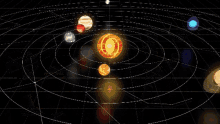
Mercury ☿
Mercury represents the exchange and transfer of all things, which includes :
— communication and transferring one’s thoughts to others through speaking or writing.
— mental processes
— money & trade
— traveling
— intelligence
— sleight of hand
— psychopomp
— thievery
↳ trivia :
— Domicile: Gemini, Virgo
— Exaltation: Virgo
— Detriment: Sagittarius, Pisces
— Fall: Pisces
— Mercury is never more than one sign away from the sun (previous and next). For example, an Aries sun person can only have Mercury in Aries, Pisces or Taurus.
— Quality: Cold and Dry (Melancholic).
— Neutral disposition, i.e. neither feminine nor masculine.
— Slightly Diurnal.
— Colors: patterns, multicolour, mixed colors, shades of gray.
— Places: Markets, shops, money-related places, schools.
— Day of the Week: Wednesday.
— Professions: messengers, agents, dealers, astrologers, clerks, accountants, scribes, media, physicians, researchers, scientists, lawyers, orators, musicians, bankers.
— Body Parts: Tongue, brain, arms, hands, fingers, auditory system, shoulders.
— Animals: small or clever animals, animals capable of “speech” (such as parrots).
— Minerals & Stones: Copper, brass, quicksilver.
Venus ♀
Venus represents relationships and social connections of all kinds, not just romantic. She also lords over the arts, beauty, harmony, peace, pleasure, diplomacy, fashion, hygiene & desire.
↳ trivia :
— Domicile: Taurus, Libra
— Exaltation: Pisces
— Detriment: Aries, Scorpio
— Fall: Virgo
— How her nature was perceived varied based on whether she appeared as Morning Star Venus (Phosphorus) or as the Evening Star (Hesperus).
— Quality : Cold and Moist (phlegmatic).
— Nocturnal.
— Feminine.
— Places: places that gives pleasure and entertainment, places depicting arts, fashion halls, gardens.
— Day of the Week: Friday.
— Body Parts: Kidney, smell, neck, hips, genitals.
— Colors: White, Green, Pink, Red.
— Professions: Musicians, artists, players, jewellers, actors, designers, perfumers, inventors, diplomats, cosmetologists.
— Minerals & stones: Copper & Emerald
— Animals: doves, soft & cuddly animals, swans
Mars ♂
Mars is a malefic, and thus represents things that are not pleasant, but usually necessary such as cutting, burning, (literal and metaphorical) severing. It also encompasses anger, aggression, the assertion of will, fire, danger, combat, war, violence, & power.
↳ trivia :
— Domicile: Aries, Scorpio
— Exaltation: Capricorn
— Detriment: Taurus, Libra
— Fall: Cancer
— Quality : Dry and Hot (choleric).
— Nocturnal.
— Masculine.
— Places: smithies, furnaces, slaughterhouses, sources of fire/burning, places of combat, hospitals, places related to the military.
— Colors: Red, vermillion, fiery colors.
— Parts: Head, gallbladder, genitals.
— Professions: professions that involve fire, butchers, conquerors, military professions, blacksmiths, surgeons, physicians, medical workers, chemists, pharmacists & herbalists.
— Day of the Week: Tuesday
— Minerals & stones: iron, sulfur, heliotrope
— Animals: dogs, foxes, canines, panther, tigers, animals that bite or sting
Jupiter ♃
Among its general significations we can list: dignity, abundance, knowledge, justice, high mindedness, expansion, generosity, prosperity, good fortune, and miracles. Jupiter also governs religion & long distance travel (as opposed to Moon & Mercury which rule over short-distance travel).
↳ trivia :
— Domicile: Sagittarius, Pisces
— Exaltation: Cancer
— Detriment: Gemini, Virgo
— Fall: Capricorn
— Quality : Warm and Moist (sanguine).
— Diurnal.
— Masculine.
— Colors: Blue, blue-greens, purple, light gray.
— Profession: Judges, professions relating to government, profession relating to religion (i.e. priests), lawyers, professors, teachers, gurus.
— Places: courts, colleges & universities, observatories, religious sites & places of prayer, altars, places that gathers large group of people.
— Day of the Week: Thursday.
— Minerals & Stones: sapphire, citrine, amethyst.
— Body Parts: Thighs, feet, liver, blood, semen.
— Animals: stag, ox, bees, eagle, dolphin, whale, sheep, deer.
Saturn ♄
Saturn embodies a sense of restriction, solitude, decay, and the passage of time. It brings with it a mix of constructive (or not) challenges and somber reflections. It's a planet that evokes emotions of sorrow, misery, and grief, and is thus often associated with death. Symbolically linked to the land and the elderly, it represents things that are enduring and long-lasting. It's also associated with locks, suggesting a sense of confinement or constraint.
↳ trivia :
— Domicile: Capricorn, Aquarius
— Exaltation: Libra
— Detriment: Cancer, Leo
— Fall: Aries
— Quality: Cold and Dry (melancholic).
— Diurnal.
— Colors: dark colors, shades of brown, nudes.
— Profession: farmers, laborers, miners, professions of construction, professions related to the dead.
— Places: deserts, prisons, ruins, graveyards, fields, abandoned places, mines, anything underground,
— Day of the Week: Saturday
— Body Parts: Bones, teeth, skin, joints
— Animals: Cats, scavengers, adders, asps, serpents, and cockatrices
— Minerals & stones: metal, lead, lapis lazuli.
PART 1 : sun/moon/rising.
#astrology#astro notes#hellenistic astrology#astrology basics#astro basics series#mercury#venus#mars#jupiter#saturn#planetary significations#astro observations
121 notes
·
View notes
Text


NSF NOIRLab astronomers discover the fastest-feeding black hole in the early universe
NSF NOIRLab Astronomers Discover the Fastest-Feeding Black Hole in the Early Universe — Observations from JWST and Chandra reveal a low-mass supermassive black hole that appears to be consuming matter at over 40 times the theoretical limit
Supermassive black holes exist at the center of most galaxies, and modern telescopes continue to observe them at surprisingly early times in the Universe’s evolution. It’s difficult to understand how these black holes were able to grow so big so rapidly. But with the discovery of a low-mass supermassive black hole feasting on material at an extreme rate, seen just 1.5 billion years after the Big Bang, astronomers now have valuable new insights into the mechanisms of rapidly growing black holes in the early Universe.
LID-568 was discovered by a cross-institutional team of astronomers led by International Gemini Observatory/NSF NOIRLab astronomer Hyewon Suh. They used the James Webb Space Telescope (JWST) to observe a sample of galaxies from the Chandra X-ray Observatory’s COSMOS legacy survey. This population of galaxies is very bright in the X-ray part of the spectrum, but are invisible in the optical and near-infrared. JWST’s unique infrared sensitivity allows it to detect these faint counterpart emissions.
LID-568 stood out within the sample for its intense X-ray emission, but its exact position could not be determined from the X-ray observations alone, raising concerns about properly centering the target in JWST’s field of view. So, rather than using traditional slit spectroscopy, JWST’s instrumentation support scientists suggested that Suh’s team use the integral field spectrograph on JWST’s NIRSpec. This instrument can get a spectrum for each pixel in the instrument’s field of view rather than being limited to a narrow slice.
“Owing to its faint nature, the detection of LID-568 would be impossible without JWST. Using the integral field spectrograph was innovative and necessary for getting our observation,” says Emanuele Farina, International Gemini Observatory/NSF NOIRLab astronomer and co-author of the paper appearing in Nature Astronomy.
JWST’s NIRSpec allowed the team to get a full view of their target and its surrounding region, leading to the unexpected discovery of powerful outflows of gas around the central black hole. The speed and size of these outflows led the team to infer that a substantial fraction of the mass growth of LID-568 may have occurred in a single episode of rapid accretion. “This serendipitous result added a new dimension to our understanding of the system and opened up exciting avenues for investigation,” says Suh.
In a stunning discovery, Suh and her team found that LID-568 appears to be feeding on matter at a rate 40 times its Eddington limit. This limit relates to the maximum luminosity that a black hole can achieve, as well as how fast it can absorb matter, such that its inward gravitational force and outward pressure generated from the heat of the compressed, infalling matter remain in balance. When LID-568’s luminosity was calculated to be so much higher than theoretically possible, the team knew they had something remarkable in their data.
“This black hole is having a feast,” says International Gemini Observatory/NSF NOIRLab astronomer and co-author Julia Scharwächter. “This extreme case shows that a fast-feeding mechanism above the Eddington limit is one of the possible explanations for why we see these very heavy black holes so early in the Universe.”
These results provide new insights into the formation of supermassive black holes from smaller black hole ‘seeds’, which current theories suggest arise either from the death of the Universe’s first stars (light seeds) or the direct collapse of gas clouds (heavy seeds). Until now, these theories lacked observational confirmation. “The discovery of a super-Eddington accreting black hole suggests that a significant portion of mass growth can occur during a single episode of rapid feeding, regardless of whether the black hole originated from a light or heavy seed,” says Suh.
The discovery of LID-568 also shows that it’s possible for a black hole to exceed its Eddington limit, and provides the first opportunity for astronomers to study how this happens. It’s possible that the powerful outflows observed in LID-568 may be acting as a release valve for the excess energy generated by the extreme accretion, preventing the system from becoming too unstable. To further investigate the mechanisms at play, the team is planning follow-up observations with JWST.
TOP IMAGE: This artist’s illustration shows a red, early-Universe dwarf galaxy that hosts a rapidly feeding black hole at its center. Using data from NASA’s JWST and Chandra X-ray Observatory, a team of U.S. National Science Foundation NOIRLab astronomers have discovered this low-mass black hole at the center of a galaxy just 1.5 billion years after the Big Bang. It is accreting matter at a phenomenal rate — over 40 times the theoretical limit. While short lived, this black hole’s ‘feast’ could help astronomers explain how supermassive black holes grew so quickly in the early Universe.Credit NOIRLab/NSF/AURA/J. da Silva/M. Zamani
LOWER IMAGE: This artist’s illustration shows a rapidly feeding black hole that is emitting powerful gas outflows. Using data from NASA's JWST and Chandra X-ray Observatory, a team of U.S. National Science Foundation NOIRLab astronomers have discovered this low-mass black hole at the center of a galaxy just 1.5 billion years after the Big Bang. It is accreting matter at a phenomenal rate — over 40 times the theoretical limit. While short lived, this black hole’s ‘feast’ could help astronomers explain how supermassive black holes grew so quickly in the early Universe. Credit NOIRLab/NSF/AURA/J. da Silva/M. Zamani
7 notes
·
View notes
Text
#SomewhereDeepInTheNight "The international #GeminiObservatory composite color image of the planetary nebula CVMP 1 imaged by the Gemini Multi-Object Spectrograph on the Gemini South telescope on Cerro Pachón in Chile." NOIRLab
#Gemini Observatory#Astronomy#Planetary Nebula#CVMP1#NOIR Lab#Gemini Multi-Object Spectrograph#Somewhere Deep In The Night#And A Sky Full Of Stars
0 notes
Text

Full view of Jupiter in infrared light (Image via International Gemini Observatory/ NOIRLab/ NSF/ AURA/ M.H. Wong (UC Berkeley) et al./ M. Zamani)
6 notes
·
View notes
Text

Hawai`i - December 16th, 1995.
"Aloha! With the graceful arc of the Earth's limb in the background, the entire Hawaiian Island archipelago is visible in this stunning photo taken by the astronauts onboard the shuttle Discovery in October of 1988. Along with popular beaches and tropical resorts, these volcanic islands offer extreme elevations with dark, dry, cloudless skies. Consequently, they have also become popular sites for sophisticated ground based telescopes. The peak of Mauna Kea, on the Big Island (upper left), boasts an impressive array of astronomical instruments including the Keck Telescope, the Canada-France-Hawaii Telescope, the NASA IRTF, the JCMT and UKIRT, and the Gemini Telescope Project. The dormant volcanic cone of Haleakala on Maui (just below the Big Island) is home to the Air Force Maui Optical Station and the Mees Solar Observatory. Mahalo nui loa!"
21 notes
·
View notes
Photo

The Southern Cliff in the Lagoon
Credits: Dept. Fisica, Univ. de La Serena, ICATE-CONICET, Gemini Observatory/AURA
106 notes
·
View notes
Photo

2023 March 3
RCW 86: Historical Supernova Remnant Image Credit: CTIO/NOIRLab/DOE/NSF/AURA, T.A. Rector (Univ.of Alaska/NSF’s NOIRLab), J. Miller (Gemini Obs./NSF’s NOIRLab), M. Zamani & D. de Martin (NSF’s NOIRLab)
Explanation: In 185 AD, Chinese astronomers recorded the appearance of a new star in the Nanmen asterism. That part of the sky is identified with Alpha and Beta Centauri on modern star charts. The new star was visible to the naked-eye for months, and is now thought to be the earliest recorded supernova. This deep telescopic view reveals the wispy outlines of emission nebula RCW 86, just visible against the starry background, understood to be the remnant of that stellar explosion. Captured by the wide-field Dark Energy Camera operating at Cerro Tololo Inter-American Observatory in Chile, the image traces the full extent of a ragged shell of gas ionized by the still expanding shock wave. Space-based images indicate an abundance of the element iron in RCW 86 and the absence of a neutron star or pulsar within the remnant, suggesting that the original supernova was Type Ia. Unlike the core collapse supernova explosion of a massive star, a Type Ia supernova is a thermonuclear detonation on a white dwarf star that accretes material from a companion in a binary star system. Near the plane of our Milky Way galaxy and larger than the full moon on the sky this supernova remnant is too faint to be seen by eye though. RCW 86 is some 8,000 light-years distant and around 100 light-years across.
∞ Source: apod.nasa.gov/apod/ap230303.html
105 notes
·
View notes